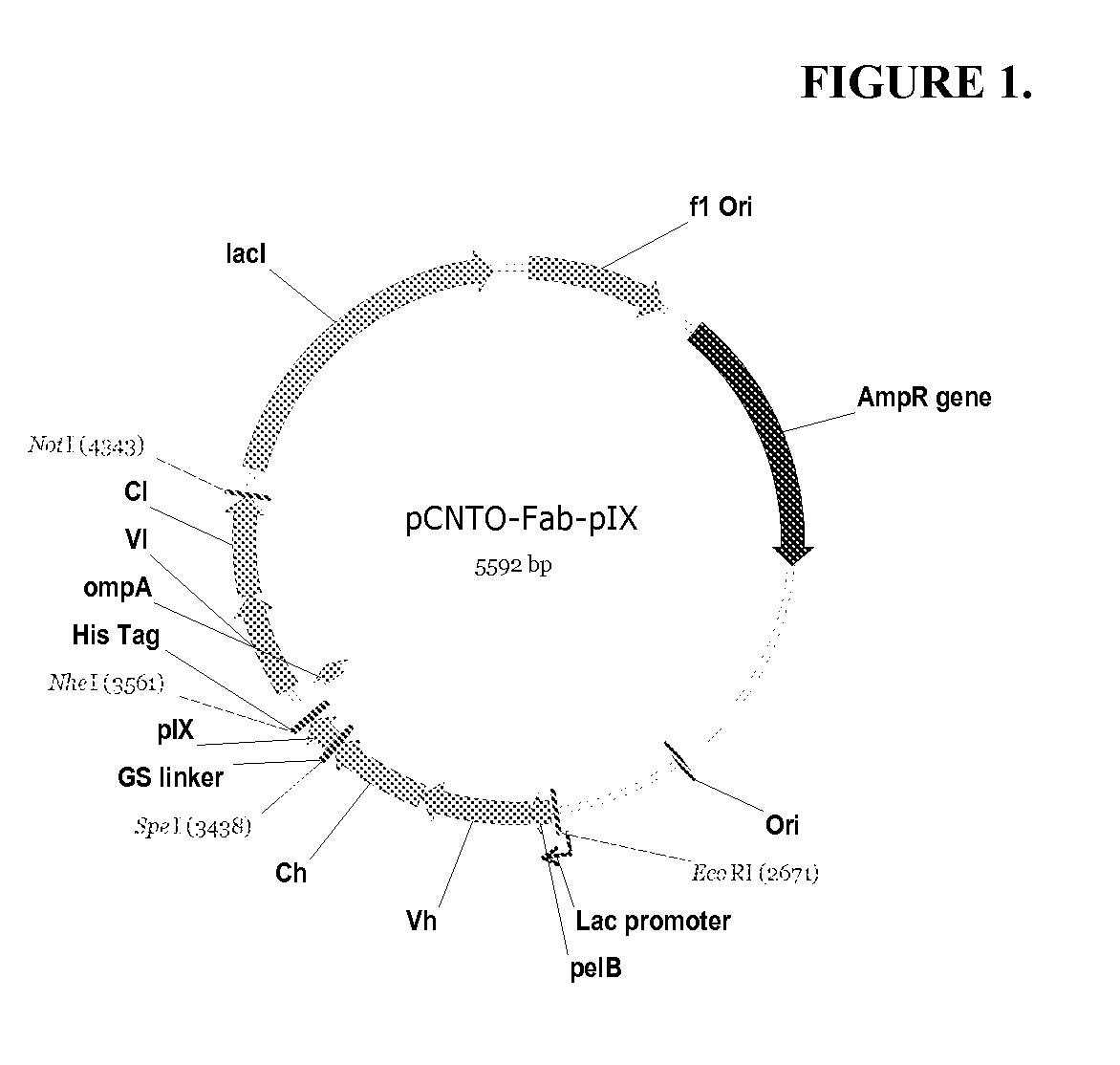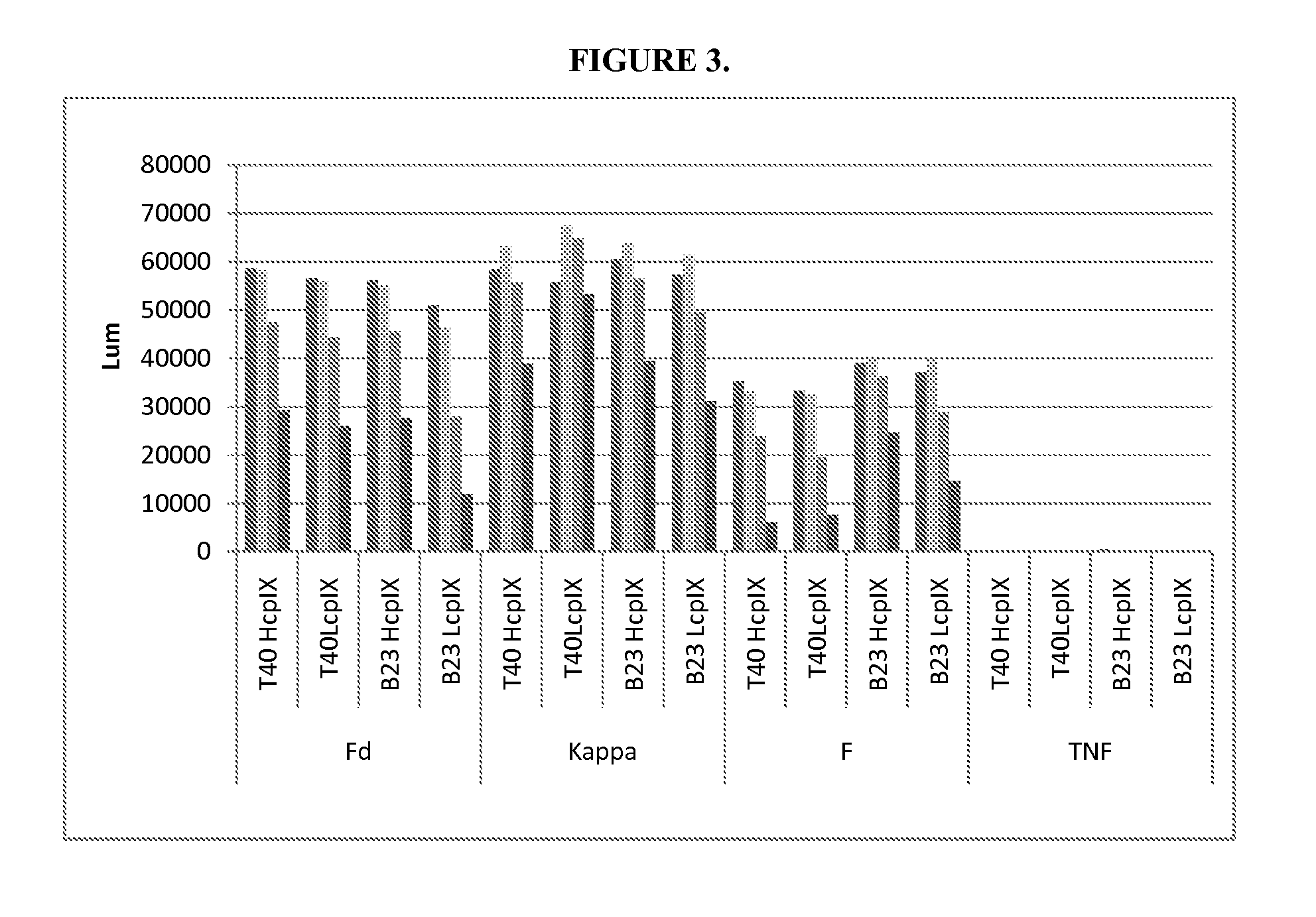DESIGN AND GENERATION OF HUMAN DE NOVO pIX PHAGE DISPLAY LIBRARIES
a technology of display libraries and phages, applied in the field of design and generation of human de novo pix phage display libraries, can solve the problems of having to repeat the library generation process, phage libraries also suffer from problems, and cannot fully encompass or mimic the full range of human immune diversity, so as to facilitate the understanding of the structure-function relationship and improve combinatorial diversities
- Summary
- Abstract
- Description
- Claims
- Application Information
AI Technical Summary
Benefits of technology
Problems solved by technology
Method used
Image
Examples
example 1
Display and Selection of Fab on pIX
[0070]The vector, pCGMT9, (Gao et al., Proc. Natl. Acad. Sci. 96, 6025-6030, 1999), served as the backbone for the development of a phagemid vector capable of inserting heavy and light chain variable region segments in a Fab format for phage display via pIX fusion to the Fd or Lc fragments. FIG. 1 shows the features of the dual display and expression vector pCNTO-Fab-pIX, as designed for display of Fd linked to pIX. For light chain linked display, the Fd and Lc fragments are swapped such that Lc is fused to pIX and Fd is the soluble secreted fragment. Either phagemid vector can be converted to a Fab expression vector upon excising the pIX gene. To evaluate display via Fd or Lc, two different Fabs specific for the respiratory syncytial virus (RSV) F protein, Fab T40 (Tsui et. al., J. Immunolo. Meth. 263, 123-132, 2002) and Fab B23 (WO / 2006 / 050280), were cloned into the pCNTO vectors. Both Fabs have kappa light chains. Cloned phage were generated for...
example 2
Display and Selection of Fab Libraries on PIX for Affinity Maturation
[0071]The demonstration of display and efficient antigen-based enrichment of Fabs indicated that the pIX system could be applied to select variants from antibody libraries. Thus, Fab display using Fd linked to pIX was employed to search for variants of the B23 Fab with improved binding affinity. A library (P-1) was designed in which 4 amino acid residues in CDR1 of the light chain sequence were mutated to all other 19 amino acids using NNK as the codon at these positions. These positions are Y31, N32, I34, and Y36. The calculated possibility of variants at the amino acid level in P-1 is 1.6×105, corresponding to 1.1×106 variants in DNA.
[0072]Kunkel's single stranded mutagenesis method (Kunkel, Proc. Nat. Acad. Sci. 82: 448, 1985) was used to construct the P-1 library. Firstly, a plasmid template was created that contained stop codons in the region to be mutated so that any unmutated template contamination in the li...
example 3
Fab De Novo Libraries
[0087]The efficiency of Fd display on the pIX coat protein, and its successful application to libraries for Fab affinity maturation, provided a rationale for extension of this methodology to de novo Fab libraries for isolation of antibodies to a variety of antigens.
[0088]3.1. Design Of Library Scaffolds. Human germline genes were selected as library scaffolds. A panel of germline VH and VL genes were initially identified based on the properties of 1) usage in known human antibody sequences; 2) canonical structure classes favoring protein and peptide antigen recognition; 3) biochemical and biophysical properties of antibodies derived from the germline genes; and 4) likelihood of forming of VH and VL hetero-dimers. Four (4) VH and four (4) VL germline genes best representing the properties listed above were selected. A single H-CDR3 sequence of 10 amino acids derived from a known antibody and the human JH4 segment were used in combination with each germline VH to ...
PUM
| Property | Measurement | Unit |
|---|---|---|
| Molar density | aaaaa | aaaaa |
| Molar density | aaaaa | aaaaa |
| Molar density | aaaaa | aaaaa |
Abstract
Description
Claims
Application Information
 Login to View More
Login to View More - R&D
- Intellectual Property
- Life Sciences
- Materials
- Tech Scout
- Unparalleled Data Quality
- Higher Quality Content
- 60% Fewer Hallucinations
Browse by: Latest US Patents, China's latest patents, Technical Efficacy Thesaurus, Application Domain, Technology Topic, Popular Technical Reports.
© 2025 PatSnap. All rights reserved.Legal|Privacy policy|Modern Slavery Act Transparency Statement|Sitemap|About US| Contact US: help@patsnap.com



